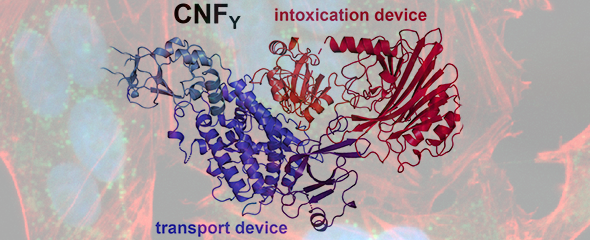Yersinia pseudotuberculosis is a microbe that causes food poisoning and is considered a parent of Yersinia pestis, the causative agent of the plague. To cause disease, it uses a toxin named cytotoxic necrotizing factor (CNF) by its ability to cause necrosis when injected into the skin. Several pathogenic strains of Escherichia coli also produce CNF. “Despite different pathogenic species using it, little is known about the three-dimensional structure of CNFs. Hence, a detailed understanding of the mechanisms that lead to intoxication is lacking,” says Prof Wulf Blankenfeldt, head of the department “Structure and Function of Proteins“ at HZI. This precludes the development of medicines that could inhibit CNF and the translational use of parts of CNF for biomedical applications.
In the current study, Blankenfeldt collaborated with several research groups from HZI and the former HZI group leader Prof Petra Dersch, now at the University of Münster, to solve the three-dimensional structure of CNF from Y. pseudotuberculosis. The scientists broke CNF into smaller pieces to visualize the complete toxin. They found that CNFs consist of five connected building blocks. “As structural biologists, we normally relate the protein structures we find to one or several of the over 170,000 structures that have already been determined previously and that are freely available through the internet. This was not the case for CNF: Only the structure of the very last building block had been investigated approximately 20 years ago. It was not even clear that the rest of CNF would contain four more structural units,“ says Blankenfeldt. The CNF structure presented by his team can now serve as a blueprint to develop inhibitors that neutralize the toxin.
In order to cause disease, the bacteria must bring toxins and other molecular weapons to the correct site of the host. The researchers discovered that the first three building blocks together establish a transport device that brings the poisonous part of CNF into the cell. Without this built-in delivery system, the two building blocks that form the poisonous segment of the toxin cannot function as they get stuck in a compartment called endosome. The stalled toxin cannot reach the molecules it interacts with to kill the cell. “Many bacteria use toxins that must accomplish the transportation into the host cell. Therefore, our results could also give insights into the molecular mechanisms of other toxins,” says Blankenfeldt. Additionally, he sees a potential application of the CNF transport machinery for novel protein-based drugs. Using the knowledge of the transport machine, therapeutic proteins can be fused to the CNF transport apparatus to overcome the obstacle of delivering them into the cell.
Original publication:
Paweena Chaoprasid*, Peer Lukat*, Sabrina Mühlen*, Thomas Heidler, Emerich-Mihai Gazdag, Shuangshuang Dong, Wenjie Bi, Christian Rüter, Marco Kirchenwitz, Anika Steffen, Lothar Jänsch, Theresia E. B. Stradal, Petra Dersch# & Wulf Blankenfeldt#. Crystal structure of bacterial cytotoxic necrotizing factor CNFY reveals molecular building blocks for intoxication. EMBO J. January 2021. DOI: 10.15252/embj.2020105202 (* contributed equally, # corresponding authors)
